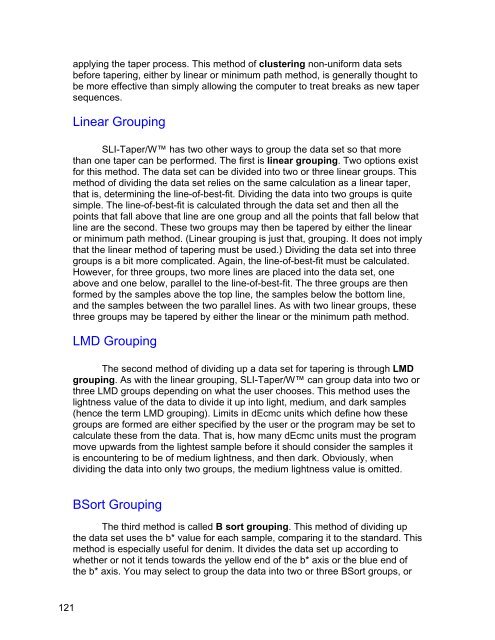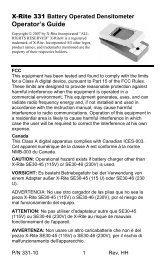Color iQC Help - X-Rite
Color iQC Help - X-Rite
Color iQC Help - X-Rite
Create successful ePaper yourself
Turn your PDF publications into a flip-book with our unique Google optimized e-Paper software.
applying the taper process. This method of clustering non-uniform data sets<br />
before tapering, either by linear or minimum path method, is generally thought to<br />
be more effective than simply allowing the computer to treat breaks as new taper<br />
sequences.<br />
Linear Grouping<br />
SLI-Taper/W has two other ways to group the data set so that more<br />
than one taper can be performed. The first is linear grouping. Two options exist<br />
for this method. The data set can be divided into two or three linear groups. This<br />
method of dividing the data set relies on the same calculation as a linear taper,<br />
that is, determining the line-of-best-fit. Dividing the data into two groups is quite<br />
simple. The line-of-best-fit is calculated through the data set and then all the<br />
points that fall above that line are one group and all the points that fall below that<br />
line are the second. These two groups may then be tapered by either the linear<br />
or minimum path method. (Linear grouping is just that, grouping. It does not imply<br />
that the linear method of tapering must be used.) Dividing the data set into three<br />
groups is a bit more complicated. Again, the line-of-best-fit must be calculated.<br />
However, for three groups, two more lines are placed into the data set, one<br />
above and one below, parallel to the line-of-best-fit. The three groups are then<br />
formed by the samples above the top line, the samples below the bottom line,<br />
and the samples between the two parallel lines. As with two linear groups, these<br />
three groups may be tapered by either the linear or the minimum path method.<br />
LMD Grouping<br />
The second method of dividing up a data set for tapering is through LMD<br />
grouping. As with the linear grouping, SLI-Taper/W can group data into two or<br />
three LMD groups depending on what the user chooses. This method uses the<br />
lightness value of the data to divide it up into light, medium, and dark samples<br />
(hence the term LMD grouping). Limits in dEcmc units which define how these<br />
groups are formed are either specified by the user or the program may be set to<br />
calculate these from the data. That is, how many dEcmc units must the program<br />
move upwards from the lightest sample before it should consider the samples it<br />
is encountering to be of medium lightness, and then dark. Obviously, when<br />
dividing the data into only two groups, the medium lightness value is omitted.<br />
BSort Grouping<br />
The third method is called B sort grouping. This method of dividing up<br />
the data set uses the b* value for each sample, comparing it to the standard. This<br />
method is especially useful for denim. It divides the data set up according to<br />
whether or not it tends towards the yellow end of the b* axis or the blue end of<br />
the b* axis. You may select to group the data into two or three BSort groups, or<br />
121












